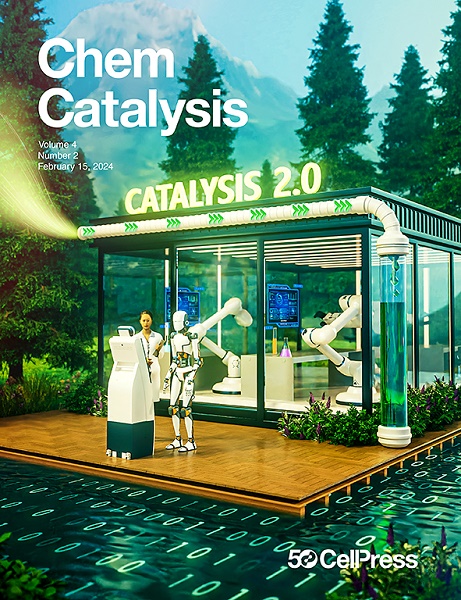Electron-acceptor-controlled polyimides for photoredox-neutral trifluoromethylation
IF 11.5
Q1 CHEMISTRY, PHYSICAL
引用次数: 0
Abstract
Heterogeneous photocatalysts present notable benefits over homogeneous systems. However, their application is often hindered by spontaneous electron-hole recombination, undermining photoconversion efficiency. Addressing this, our study introduces a diversity-oriented synthesis of electron-donor-acceptor (D-A)-type polyimides via N-amidation of aromatic dianhydrides with anilines. These polyimides exhibit segregated D-A alignments that facilitate enhanced charge separation, rapid electron transfer, and long-lived photogenerated electron-hole pairs, attributed to superior electron-donating and -accepting capabilities alongside predictable π-π stacking. Their efficacy is demonstrated in catalyzing visible-light-driven redox-neutral C–H trifluoromethylation, transforming pharmaceuticals and bioactive molecules into trifluoromethyl-functionalized products with high yield and selectivity. A continuous-flow fixed-bed photoreactor supports gram-scale synthesis, and the photocatalyst maintains activity through at least four recycling rounds. Time-dependent density functional theory (TD-DFT) and non-covalent interaction (NCI) analyses suggest that the observed performance enhancement is due to controlled photoinduced electron transfer within the D-A system and intrachain π-π stacking.

用于光氧化中性三氟甲基化反应的电子受体控制聚酰亚胺
与同质系统相比,异质光催化剂具有显著的优势。然而,它们的应用往往受到自发电子-空穴重组的阻碍,从而影响光电转换效率。为了解决这个问题,我们的研究通过芳香族二酐与苯胺的 N-酰胺化,介绍了一种以多样性为导向的电子供体-受体(D-A)型聚酰亚胺的合成方法。这些聚酰亚胺显示出分离的 D-A 排列,有利于增强电荷分离、快速电子转移和长寿命光生电子-空穴对,这归功于其卓越的电子供体和受体能力以及可预测的 π-π 堆积。它们在催化可见光驱动的氧化还原中性 C-H 三氟甲基化反应、将药物和生物活性分子转化为高产率和高选择性的三氟甲基功能化产物方面的功效得到了证实。连续流固定床光反应器支持克级规模的合成,光催化剂可在至少四轮循环中保持活性。与时间相关的密度泛函理论(TD-DFT)和非共价相互作用(NCI)分析表明,所观察到的性能提高是由于 D-A 系统内受控制的光诱导电子转移和链内π-π堆叠。
本文章由计算机程序翻译,如有差异,请以英文原文为准。
求助全文
约1分钟内获得全文
求助全文
来源期刊
CiteScore
10.50
自引率
6.40%
发文量
0
期刊介绍:
Chem Catalysis is a monthly journal that publishes innovative research on fundamental and applied catalysis, providing a platform for researchers across chemistry, chemical engineering, and related fields. It serves as a premier resource for scientists and engineers in academia and industry, covering heterogeneous, homogeneous, and biocatalysis. Emphasizing transformative methods and technologies, the journal aims to advance understanding, introduce novel catalysts, and connect fundamental insights to real-world applications for societal benefit.

 求助内容:
求助内容: 应助结果提醒方式:
应助结果提醒方式:


